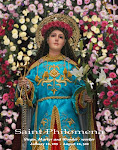AS THEY WERE coming down the
mountain of the transfiguration, the disciples were charged by the Lord not to
relate what they had seen to anyone, except when the Son of Man had risen from
the dead. “So they kept the matter to themselves, questioning what rising from
the dead meant.” Early in that Easter morning, Peter and John (2 of those who
saw the transfiguration) ran to the tomb of Jesus when they heard of the Lord’s
missing body. Both of them entered the tomb and saw the shroud or burial cloths
rolled up. At last they were confronted by the reality they were questioning.
They came to stand face to face with the reality of the rising of Jesus from
the dead. This is what rising from the dead meant.
St. John saw and believed. People
may see the evidence of an empty tomb and see nothing in its emptiness. John
saw the empty tomb and realized that its emptiness was itself the evidence of
the resurrection. John saw with his own eyes how the Lord died on the Cross. He
himself stood beneath the Cross. He saw blood and water flowing from the Lord’s
wounded side. He himself brought Jesus’ lifeless body to the tomb. Now, the
Lord is simply not there in the tomb because he has risen from the dead. He saw
and believed.
St. Peter would later on see
something from the empty tomb. Not only would he see it as simply an evidence
of the resurrection. He would see the resurrection as the evidence of the fact
that Jesus is “the one appointed by God as judge of the living and the dead. To
him all the prophets bear witness that everyone who believes in him will
receive forgiveness of sins through his name.” Having been the one who denied
the Lord thrice, Peter himself experienced his sins being forgiven by the One
who rose from the dead. The Lord
appeared to Simon. That is why Peter could testify “that God raised this man on
the third day and granted that he be visible not to all the people but to
us…who ate and drank with him after he rose from the dead.”
It was not just an empty tomb
that they saw. They did not simply see the absence of a corpse. In that empty
tomb, they saw life overcoming death. They saw mercy overcoming sin. The empty
tomb was an invitation to believe in Jesus. It was an invitation to escape the
condemnation that it ours on account of our sins. It was an invitation to
receive forgiveness from him. It was an invitation to find in him eternal life.
“For God so loved the world that he gave his only Son, so that whoever believes
in him might not perish but might have everlasting life.”
The Lord Jesus once was slain for
us but now, he lives forever. His love endures forever because he will never
die again. His immortality makes him capable of loving us forever. “Life comes
to us from being loved by him who is Life; it comes to us from living-with and
loving-with him.” (Benedict XVI, Easter Vigil 2006.)
Jesus, I trust in you. O Mary
conceived without sin, pray for us who have recourse to thee.










No comments:
Post a Comment